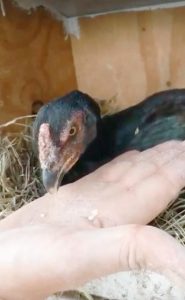
Queen Brooder
Brooding: showing deep unhappiness of thought. Setter: a person or thing that sets something. Truer words have never been spoken about brooding hens, especially this hen. Brooders. Setters. One in the same in the world of chicken as they both have the same end result.
A brooding hen can either be good or bad depending upon if 1) the hen is knowledgeable in this matter and 2) your desire to have little peppers. Having thought I had a broody chicken before, I now know I was wrong. B.U., our newest halfway house resident, is a classic book definition of a brooding chicken. In her broodiness, she is a devout guardian as she only leaves her clutch to eat, drink, and poop (which takes less than 10 minutes). Upon setting she easily deters other hens from entering to lay eggs. Two chickens in a nesting box usually results in an broken egg. With her broody clucks, she safe guards her work. Inevitably, when she leaves to do her thing, a has hen entered her domain and results in a fight. The lesser hen leaves, sometimes with a few feather missing, and she proceeds with her duties.

In fact, she so rarely eats, drinks, or poops, that when she does her droppings are sometimes four times the size of normal droppings. Perfectly normal in brooding chickens, large poop is usually used as a tale-tale sign of a brooder. Taking pity on her, when the remaining flock is let out for free range time, the coop will be closed off allowing her free time to stretch her legs at her leisure. Of course, being a strong setter, she has yet to leave her clutch of seven eggs for free time.
When eggs are collected at the end of the day, sometimes I give her a tidbit of corn and some pellets, both of which she ferociously devours. This food acts as a buffer to allow me to remove any new eggs that have been added to bunch. Not wanting to waste eggs, this is important otherwise the eggs will be at different stages of development. Brooding eggs have been marked with an X, of course, making them easy to distinguish.
From start to finish brooding takes 21 days. Today, through candling, we determined her eggs were viable. Candling is a learned skill but thankfully with detailed explanations and pictures from the University of Nebraska-Lincoln, it was accomplished. Now we just have to wait 10 more days for little peppers. Hopefully. Maybe.